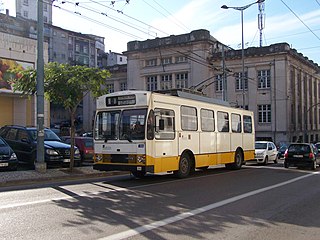
Geneva Public Transport operates most of the public transportation system in canton of Geneva, Switzerland, including the city of Geneva. The agency's head office is in Grand-Lancy, Lancy.

The Hamilton Street Railway (HSR) is the public transport agency for Hamilton, Ontario. The name is a legacy of the company's early period, when public transit in Hamilton was primarily served by streetcars. Although streetcars are no longer used in the city today, the HSR operates bus and paratransit services, with a ridership of 21 million passengers a year.

Guided buses are buses capable of being steered by external means, usually on a dedicated track or roll way that excludes other traffic, permitting the maintenance of schedules even during rush hours. Unlike trolleybuses or rubber-tyred trams, for part of their routes guided buses are able to share road space with general traffic along conventional roads, or with conventional buses on standard bus lanes.

The Boston-area trolleybus system formed part of the public transportation network serving Greater Boston in the U.S. state of Massachusetts. It opened on April 11, 1936, with a large network operating for the next quarter-century. Measured by fleet size, the Boston-area system was the second-largest trolleybus system in the United States at its peak, with only the Chicago system having more trolleybuses than Boston's 463. After 1963, the only remaining portion was a four-route cluster operating from the Harvard bus tunnel at Harvard station, running through Cambridge, Belmont, and Watertown. The Massachusetts Bay Transportation Authority took over the routes in 1964.

The Metrobus is a 52 km (32.3 mi) bus rapid transit route in Istanbul, Turkey. The system has 44 stations that follow the city's ring road via Avcılar, Zincirlikuyu and the Bosphorus Bridge to Söğütlüçeşme using dedicated bus lanes for almost the entire length of the route.

The Rome trolleybus system forms part of the public transport network of the city and comune of Rome, Italy. In operation since 2005, the current system comprises three routes.
The İzmir trolleybus system formed part of the public transport network in the city of İzmir, Turkey, from 1954 to 1992. Operated by ESHOT, the system was one of five trolleybus systems to have existed in Turkey, along with ones in Ankara, Istanbul, Malayta, and Sanliurfa. Prior to the opening of the Malatya system, in 2015, the İzmir system had been the last surviving trolleybus system in Turkey at the time of its closure in 1992. Trolleybuses operated mainly in Konak, with lines to Buca, Balçova and Tepecik.

The Lausanne trolleybus system forms part of the public transport network of Lausanne, in the canton of Vaud, Switzerland. The system has been in operation since 1932 and is the third-oldest surviving trolleybus system in the world, after those of Shanghai and Philadelphia.

The Santos trolleybus system forms part of the public transport network in Santos, a municipality in the state of São Paulo, Brazil. Opened on 12 August 1963, it presently comprises only one line, and, along with the two São Paulo metropolitan area trolleybus systems, is one of only three trolleybus systems still operating in Brazil.

The Coimbra trolleybus system forms part of the public transport network in the city of Coimbra, Portugal. Opened in 1947, it supplemented, and then eventually replaced, the Coimbra tramway network. Service has been temporarily suspended since March 2021 and is not expected to resume before late 2024.

The Rimini trolleybus system forms part of the public transport network of the Province of Rimini, in the region of Emilia-Romagna, Italy.

The La Chaux-de-Fonds trolleybus system forms part of the public transport network in La Chaux-de-Fonds, in the canton of Neuchâtel, Switzerland.

The Geneva trolleybus system forms part of the public transport network in Geneva, Switzerland. It is the second largest trolleybus system in Switzerland, after the Lausanne system.

The St. Gallen trolleybus system forms part of the public transport network of St. Gallen, the capital city of the canton of St. Gallen, Switzerland.
The Sumqayit trolleybus system was a system of trolleybuses forming part of the public transport service in Sumqayit, the third most populous city in Azerbaijan, for most of the second half of the 20th century.

The Montreux/Vevey trolleybus system, also known as the Vevey–Villeneuve trolleybus line, forms part of the public transport network in Montreux and Vevey, in the canton of Vaud, Switzerland. It comprises a single 12.75 km (7.92 mi) long trolleybus route along the length of the Riviera vaudoise on the north shore of Lake Geneva.

The Chișinău trolleybus system forms an important part of the public transport network in Chișinău, the capital of Moldova. The system was created shortly after the end of the World War II to replace the old electric tram system that suffered extensive damage during the war. Along with the network of minibuses known as rutierele, it forms the backbone of the Chișinău transport system, with the average daily ridership reaching 250,000 passengers per day.

BRT Marrakesh is a bus rapid transit system that is also partly trolleybus in Marrakesh, Morocco. It opened on 29 September 2017. The system is officially known as Bus à Haut Niveau de Service de Marrakech, which equates to the English term Bus Rapid Transit, or BRT, of Marrakesh. Although the buses are equipped to operate as trolleybuses, only part of the system is fitted with overhead wiring for trolleybuses, and the vehicles operated on batteries over the other sections.

Metromare is a 9.8 km (6.1 mi) trolleybus rapid transit line in the province of Rimini, Italy. Part of Rimini's trolleybus system, the line runs between the railway stations of Rimini and Riccione on a segregated track beside the Bologna–Ancona railway. 15 intermediate stops serve the coastal suburbs, the touristic seafront, Federico Fellini International Airport, and the Fiabilandia amusement park. The service is operated by Start Romagna SpA, and launched in November 2019.



















